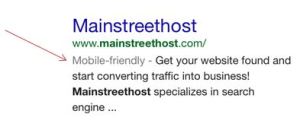SEO five years ago, or even one year ago, is quite different from the SEO of today. Google has implemented several changes to its algorithms that affect how searchers get results, and how marketers get your website found. People today are also spending a lot more time searching on mobile devices, which presents a whole new set of guidelines to adhere to.
With Google algorithms changing upwards of 600 times per year, it can seem like a daunting task to try and keep up! Below are four things to keep in mind as SEO begins to place a stronger emphasis on website content and optimizing for mobile devices.
You can’t trick Google into improving your placement.
The days of “keyword stuffing” to improve your search engine ranking are officially over. SEO is no longer a game or a formula; you can’t just throw keywords around the pages of your website and miraculously appear at the top spot, or even on the first couple of pages. There is still a lot of value in analyzing the data provided on each keyword’s performance, but it’s important to keep in mind that measures have been taken so that you cannot manipulate the system.
Recent updates such as the Penguin and Panda algorithms indicate that Google is permanently stopping this black hat practice and is focused on providing users with the quality content they are looking for. While keywords still play a role in your ranking, it is expected that we will continue to shift away from this methodology and focus more on the complete user experience.
Content has become a primary consideration for ranking.
Google and other search engines are beginning to emphasize the importance of building websites that educate and provide a positive user experience, in addition to the effective use of keywords. As search becomes more complex, they are now considering how people search through “long-tail” keywords and phrases that are much more conversational. Whether you are building a website from scratch or have had one for years, now is the time to evaluate your online branding and content to make sure your site is found.
Consumers have more power than ever when it comes to search. The algorithms in place now have the capability of handling detailed queries. In order to answer the questions that users are searching for, it is crucial that you create content to cater to this format. Blogs, social media, and rich website text and images all lend themselves to answering searches entered in the form of a question or statement (i.e. Best Italian Restaurants in Buffalo, NY). If your website has quality content while including keywords here and there, you should generally be able to rank well.
This doesn’t mean you need to throw out all old or existing content on your website. Go through old blog or social media posts and find ways to repurpose them by updating text or graphics. This, in addition to new content creation, will maximize the effectiveness of your SEO strategy.
SEO is no longer just about numbers and statistics.
If you haven’t gotten the hint by now, SEO isn’t just about keywords anymore. And it’s not even just about search engines anymore. Companies are starting to make SEO a part of their social media strategy as well, creating insightful posts and images that make you easier to find through a search engine. Many studies and data point to social media having an SEO impact. By developing a social presence, quality content, and engaging your community, it can translate into improved search rankings. It’s important to keep in mind that when trying to improve your SEO, you shouldn’t just focus on your website. SEO takes into account your online presence as a whole, and with social media’s vast influence, it can’t afford to be ignored.
Another element that it appears Google is starting to take into account is user engagement once they reach your website. A site’s bounce rate, landing page conversion rates, and traffic to blogs and original content, are all being considered when determining an SEO score.
If you can’t keep people on your website for more than a page or two, then you’re unlikely to rank well. This indicates that you don’t provide the content people are looking for or you aren’t conveying it in a way that positions you as an industry expert. In the SEO world, this is called pogo-sticking, where users have to jump from search result to search result until they are able to find what they are looking for.
Focus on both the quality and appearance of your site to help this improve. Is it easy to find important information? Is the layout cluttered or disorganized? Are you established as a company that knows what it’s talking about, and do you have concrete data to back it up?
If your site isn’t mobile-friendly, it probably won’t rank well.
When you are doing a search, do you find yourself using a computer or your smart phone more often? Mobile devices are accounting for more search engine traffic than ever, with 80 percent of people using a smart phone to conduct searches. If your website hasn’t been optimized for mobile, then now is the time. The longer you wait, the more your SEO ranking will suffer.
Google is taking into account whether or not your site is mobile-friendly, by adjusting rankings and indicating to searchers which sites have been optimized. If you do a search on a mobile device, right under the website URL it will say “mobile-friendly” if the site has been designed accordingly. If you don’t have this indicator, not only will you probably see a drop in your mobile click-through rate (CTR), Google and other search engines will penalize your ranking.

SEO can be a lot to maintain and keep up with, but it is truly essential to your online presence.
Moving forward, you should focus on improving website content through thought leadership and optimize your site for mobile devices if you haven’t already done so. Taking the time to develop quality, original content like blogs and eBooks is well worth the effort. Not only will you engage visitors on your website and keep them on your site longer, but search engines will recognize this content and adjust your ranking accordingly.
As keywords begin to take a back seat, it’s important to develop an engaging user experience that will educate and build trust. Generating rapport with users will make them want to come back to your site as well as share their experience with others. These tactics, along with a solid social media strategy, will help maximize the effectiveness of your digital brand. Stay tuned, there are sure to be more changes to the SEO world soon!
In order to create quality content that is beneficial to your users, you must first know what those users want! Developing buyer personas is the first step to creating content your audience finds useful and enjoyable. Download our Buyer Persona Checklist below to get started.
(546)








